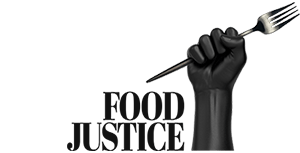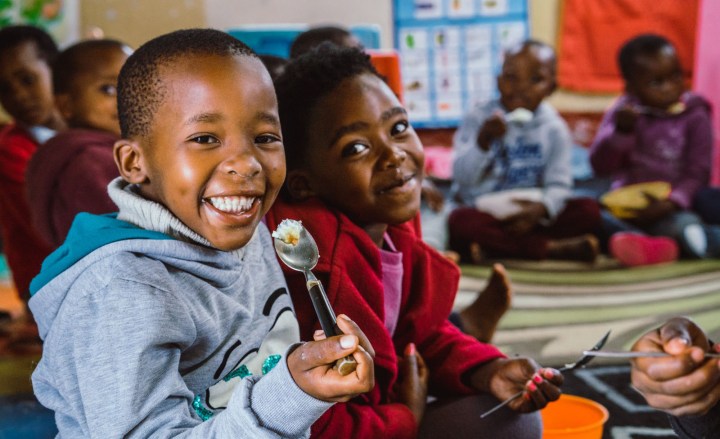
ECD REFORM OP-ED
Adequate nutrition — a key ingredient for a young child’s optimal health and development

Children in South Africa have the right to nutrition under our Constitution. But what is adequate nutrition, exactly? What does it mean to fulfil this right from a nutrition or health perspective?
A group of researchers from a range of disciplines wrote three papers that form the basis of Real Reform for ECD’s Right to Nutrition campaign. The campaign calls for an early childhood development nutrition programme that ensures all eligible young children attending early learning programmes (ELPs) have access to the nutrition they need to learn and thrive.
Nutrition is not just a need, but a child’s right under the Constitution.
In the first paper and in her op-ed for Daily Maverick, legal researcher Tatiana Kazim highlighted that the Constitution protects the right to nutrition twice: in Section 28 which speaks about the rights of children, and in Section 29 which speaks about the right to education.
Read more in Daily Maverick: Right to early nutrition: youngest children must not be left behind
Accepting that children have a right to nutrition, the next logical question is: What constitutes adequate nutrition?
An adequate diet is one that meets a person’s energy and nutritional needs based on their age and developmental needs.
When we fail to ensure that adequate nutrition is available and affordable to caregivers of young children, we see insufficiencies in dietary intake. This can lead to micronutrient deficiencies such as anaemia, or forms of undernutrition like wasting and stunting, or even overnutrition, resulting in obesity.
It is unconscionable that we have hardly seen a reduction in stunting rates since the start of democratic South Africa. Stunting – being short for one’s age – is the result of chronic hunger and infection, and robs children of their potential. The reason we talk so much about stunting is because a child’s height at age two is the best predictor of adult human capital.
In other words, the impact of poor nutrition during the earliest part of childhood has a long reach into their future: Children who suffer from stunting are less likely to finish school and earn a good income, and are more likely to live with noncommunicable diseases such as diabetes and heart disease. This is why we have to intervene early, which scientific evidence says is the best value for money. Children need nutrient-dense, diverse foods regularly to ensure they consume enough nutrients to support their growth and development.
Current nutrition support
Every child in South Africa receives a Road to Health booklet at birth. It contains lots of information for parents, including about nutrition, which starts with the recommendation to exclusively breastfeed children up to six months. Thereafter, caregivers should introduce family foods in an appropriate quantity and texture as children grow older.
For many children, the first context outside the home is an ELP and ELPs are a space where children routinely gather. This is why the Department of Health developed the Nutrition Guidelines for Early Childhood Development Centres, so that practitioners can continue to deliver adequate nutrition to the young children in their care. The guidelines include a suggested two-weekly menu cycle and standardised recipes, as well as advice on how to maintain a safe food preparation area. It also outlines the number of meals that should be provided based on the time the child spends at the programme.
Our recommendation is to capacitate the ECD sector to deliver nutrition, and the good news is that we know where to start.
The government also delivers nutrition support to children attending registered ELPs in the form of the ECD subsidy. Unfortunately, the value of that support is low – of the R17 per child per day, only R6,80 is allocated to nutrition. With current food prices, this is simply not good enough. Second, because children who attend unregistered programmes have no access to the subsidy, the coverage of the subsidy is not wide enough, especially for the most vulnerable children.
In our research process, we interviewed 10 non-governmental programmes that provide nutrition to children at ELPs across the country. Our intention was to document the ways in which nutrition is delivered to ELPs in various contexts despite the fact that only 33% of ELPs receive the subsidy according to the 2021 ECD Census.
We found that all of the nutrition providers we interviewed provided breakfast in the form of a fortified porridge. This is easy to distribute in both urban and rural contexts, and simple to prepare with minimal facilities. Most feeding schemes also provide lunch, which is typically a cooked meal. This requires some sort of kitchen, which is why a few feeding schemes deliver cooked meals to centres instead of raw ingredients.
We argue that these insights, based on years of experience, should form the basis of the Department of Basic Education’s efforts to implement a national ECD nutrition programme. Collaborating with established civil society or private sector organisations can enhance the effectiveness of nutrition programmes by leveraging their expertise, infrastructure and networks.
We also surveyed Real Reformers, members of the Real Reform for ECD movement, about their experiences of providing nutrition at their ELPs. Practitioners recognise the positive impact of quality nutrition on children’s development, and our survey data highlight the commitment of ELP principals to providing daily meals, but also highlight the challenges they face, including insufficient and unreliable funding, as well as the high costs of nutritious food and equipment.
Our recommendation is to capacitate the ECD sector to deliver nutrition, and the good news is that we know where to start. Our actions should begin with more training on the nutrition guidelines, and making sure the guidelines reflect culturally relevant and affordable foods. In these training sessions, we can build stronger relationships between the government officials who regulate and monitor the sector, and the people who actually represent the sector.
Finally, if we don’t measure children’s height routinely, we won’t know if our increased interventions are having the desired effect. We also won’t have the ability to respond to children who are at risk of stunting. Screening children for malnutrition can be done by community health workers, or ECD practitioners, or even parents. Across government departments and caregivers of young children, we have to work together to take on this important task.
We’re in luck – National Treasury has already allocated funds to the Department of Basic Education for a nutrition pilot. This is the ideal opportunity to test how nutrition can best be delivered to young children, what the sector needs and understands about nutrition, and what the impact can be.
We all know the adage “you can’t teach a hungry child” and it’s true for children of all ages – growing and developing bodies and minds need good nutrition to develop to their true potential. It is our collective responsibility to ensure our youngest children are set up to thrive – transforming the future of South Africa, one nutritious meal at a time. DM
Anna-Marie Müller led the writing of the Adequate Nutrition paper while at the DG Murray Trust. This op-ed is the second in a three-part series written by researchers who worked on three papers that informed Real Reform for ECD’s Right to Nutrition campaign. The third will look at various implementation models and their cost to get nutritious meals to eligible children attending ELPs.


















 Become an Insider
Become an Insider
Comments - Please login in order to comment.